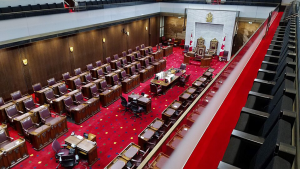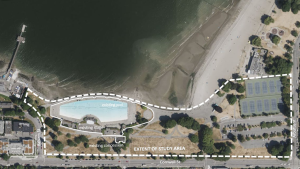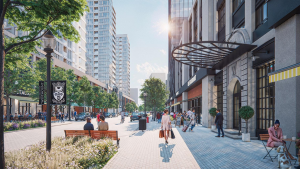The Regional District could not refuse to issue a building permit merely because of its belief that the structure would not be used for its stated purpose. Should that be the case, the District had a legal remedy it could invoke against the plaintiff.
Strict interpretation of by-law means no extensions allowed
by Michael MacKay
579340 B.C. Ltd. v. Sunshine Coast Regional District
Zoning By-law prohibits upward extension of existing non-conforming structure as well as extension at ground level
Dr. Reichman, through his company 579340 B.C. Ltd., owned a seven-acre waterfront cottage property on Ruby Lake in the Sunshine Coast Regional District. The District refused to grant him two building permits, so he applied to court to reverse the District’s decision.
The District based its refusal on its Zoning By-law 337, which prohibited all construction except boathouses within 30 metres of shore.
The Cottage
One building permit application was for an addition to Dr. Reichman’s existing cottage. Even though the cottage was situated within 30 metres of shore, it had been built before the by-law, and so was a legal non-conforming use.
Dr. Reichman planned to add a second storey — the cottage would be extended up, but would not cover any more area at ground level.
The District refused the permit for the cottage extension, saying that the proposed addition nevertheless still constituted an improper extension, because the work would add additional building mass within the setback.
Adding mass and height to the building by increasing the roof structure would be extending and locating more of the building within the setback and cannot be supported.
A portion of the building that did not previously exist would later exist in contravention of by-law.
Dr. Reichman based his court application on s. 911(10) of the Local Government Act, which limits the District’s ability to refuse building permits by expressly permitting extension or addition to existing non-conforming buildings. It says, however, that legal non-conforming structures may be extended:
…only to the extent that the… extension or alteration would, when completed, involve no further contravention of the bylaw than that existing at the time the… extension was… started.
Justice Smith had to determine whether building “up” was a “further contravention of the bylaw.” If it was, the District was right to refuse the building permit. If it wasn’t, the proposed cottage extension fell within
s. 911(10), so that the District could not refuse it.
Dr. Reichman argued that so long as the addition was no closer to the lake, the new cottage fell within the restriction created by s. 911(10) of the Local Government Act, and thus complied with the District’s Zoning By-law 337.
The District argued that Zoning By-law 337 did not just create an horizontal setback but a requirement for setback of a three-dimensional space.
Justice Smith considered the following principles:
- the purpose of the setback regulation in Zoning By-law 337 “is to keep the lakeshore clear of buildings within a 30‑metre zone”;
- Zoning By-law 337 is drafted to prohibit new building in the “setback area not only at ground level, but also in the airspace above ground level”;
- Section 911(10) of the Local Government Act exists “to ensure that owners of properties that pre-existed setback regulations… and that are therefore now non-compliant as to siting, are able to do work on those properties so long as they do not worsen the bylaw contravention”.
However, s. 911(10) did not clearly preclude prohibition against building upwards. Justice Smith concluded that, in order to give effect to the plain meaning of Zoning By-law 337, and its purpose,
…s. 911(10) must be construed to mean that any expansion of the cottage within the setback area, whether toward the lake, upward or outward, would constitute a further contravention of the bylaw. [Emphasis added.]
Justice Smith declined to interfere with the District’s decision on the cottage: she refused to order it to give Dr. Reichman a building permit. [Dr. Reichman could always apply for a variance, but he had declined to do so — whether the District would grant him one is another story. Alternatively, he had plenty of room to build a new cottage entirely outside the setback.]
The Boathouse
Dr. Reichman’s other permit application was to build a boathouse at the water’s edge. Even though Zoning By-law 337 expressly permitted boathouses to be built within 30 metres of shore, the District did not believe that Dr. Reichman’s structure was really a boathouse, and so refused a building permit.
The District argued that:
…the intention behind the exception for boathouses within the setback ‘obviously relates to the needs of users who have large boats that could not simply be stored outside of the setback and so may remain in a boathouse at the edge of the lake’….
The structure’s size and design did not look like a boathouse; however, Dr. Reichman explained all the non-boathouselike features:
- the building’s octagonal shape is more attractive than a rectangular box;
- he intended to store small inflatable rafts, kayaks and canoes less than 14 feet long;
- the windows will not hinder storage because the boats will be suspended from the ceiling.
Justice Smith set aside the District’s refusal to issue a building permit for the boathouse aside. She pointed out that, while:
[t]he proposed structure may not look like other boathouses[;]…. kayaks and canoes are boats, and this structure is designed to store them…. [T]he proposed structure does meet the definition of ‘boathouse’ set out in Bylaw 337.
The by-law did not limit the exception to boathouse for large boats. The District could not refuse to issue a building permit merely because of its belief that the structure would not be used as a boathouse. Should that be the case, the District had a legal remedy it could invoke against Dr. Reichman.
Dr. Reichman won his application on the boathouse building permit, but lost on the cottage building permit. Because success was divided, each party had to pay its own legal costs.
British Columbia Supreme Court
Smith J.
August 19, 2005










Recent Comments
comments for this post are closed